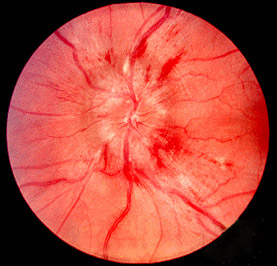Related Research Articles

Glaucoma is a group of eye diseases that lead to damage of the optic nerve, which is important for transmitting visual information from the eye to the brain. This damage is often caused by increased pressure within the eye, known as intraocular pressure (IOP) and may cause vision loss if left untreated. The word glaucoma originated from the Greek word ΓλαύV̇ξ (glaukos), which means "to glow". Glaucoma has been called the "silent thief of sight" because the loss of vision usually occurs slowly over a long period of time. It is associated with old age, a family history of glaucoma, and certain medical conditions or medications.

In neuroanatomy, the optic nerve, also known as the second cranial nerve, cranial nerve II, or simply CN II, is a paired cranial nerve that transmits visual information from the retina to the brain. In humans, the optic nerve is derived from optic stalks during the seventh week of development and is composed of retinal ganglion cell axons and glial cells; it extends from the optic disc to the optic chiasma and continues as the optic tract to the lateral geniculate nucleus, pretectal nuclei, and superior colliculus.

Papilledema or papilloedema is optic disc swelling that is caused by increased intracranial pressure due to any cause. The swelling is usually bilateral and can occur over a period of hours to weeks. Unilateral presentation is extremely rare.
The visual field is "that portion of space in which objects are visible at the same moment during steady fixation of the gaze in one direction"; in ophthalmology and neurology the emphasis is on the structure inside the visual field and it is then considered “the field of functional capacity obtained and recorded by means of perimetry”.

The optic disc or optic nerve head is the point of exit for ganglion cell axons leaving the eye. Because there are no rods or cones overlying the optic disc, it corresponds to a small blind spot in each eye.

Intraocular pressure (IOP) is the fluid pressure inside the eye. Tonometry is the method eye care professionals use to determine this. IOP is an important aspect in the evaluation of patients at risk of glaucoma. Most tonometers are calibrated to measure pressure in millimeters of mercury (mmHg).

Betaxolol is a selective beta1 receptor blocker used in the treatment of hypertension and angina. Being selective for beta1 receptors, it typically has fewer systemic side effects than non-selective beta-blockers, for example, not causing bronchospasm as timolol may. Betaxolol also shows greater affinity for beta1 receptors than metoprolol. In addition to its effect on the heart, betaxolol reduces the pressure within the eye. This effect is thought to be caused by reducing the production of the liquid within the eye. The precise mechanism of this effect is not known. The reduction in intraocular pressure reduces the risk of damage to the optic nerve and loss of vision in patients with elevated intraocular pressure due to glaucoma.

Latanoprost, sold under the brand name Xalatan among others, is a medication used to treat increased pressure inside the eye. This includes ocular hypertension and open angle glaucoma. It is applied as eye drops to the eyes. Onset of effects is usually within four hours, and they last for up to a day.
Optic neuropathy is damage to the optic nerve from any cause. The optic nerve is a bundle of millions of fibers in the retina that sends visual signals to the brain. [1].

Optic disc drusen (ODD) are globules of mucoproteins and mucopolysaccharides that progressively calcify in the optic disc. They are thought to be the remnants of the axonal transport system of degenerated retinal ganglion cells. ODD have also been referred to as congenitally elevated or anomalous discs, pseudopapilledema, pseudoneuritis, buried disc drusen, and disc hyaline bodies.

Blurred vision is an ocular symptom where vision becomes less precise and there is added difficulty to resolve fine details.
Pseudoexfoliation syndrome, often abbreviated as PEX and sometimes as PES or PXS, is an aging-related systemic disease manifesting itself primarily in the eyes which is characterized by the accumulation of microscopic granular amyloid-like protein fibers. Its cause is unknown, although there is speculation that there may be a genetic basis. It is more prevalent in women than men, and in persons past the age of seventy. Its prevalence in different human populations varies; for example, it is prevalent in Scandinavia. The buildup of protein clumps can block normal drainage of the eye fluid called the aqueous humor and can cause, in turn, a buildup of pressure leading to glaucoma and loss of vision. As worldwide populations become older because of shifts in demography, PEX may become a matter of greater concern.

Canine glaucoma refers to a group of diseases in dogs that affect the optic nerve and involve a loss of retinal ganglion cells in a characteristic pattern. An intraocular pressure greater than 22 mmHg (2.9 kPa) is a significant risk factor for the development of glaucoma. Untreated glaucoma in dogs leads to permanent damage of the optic nerve and resultant visual field loss, which can progress to blindness.

Glaucoma medication is divided into groups based on chemical structure and pharmacologic action. The goal of currently available glaucoma therapy is to preserve visual function by lowering intraocular pressure (IOP), below a level that is likely to produce further damage to the nerve.

Primary juvenile glaucoma is glaucoma that develops due to ocular hypertension and is evident either at birth or within the first few years of life. It is caused due to abnormalities in the anterior chamber angle development that obstruct aqueous outflow in the absence of systemic anomalies or other ocular malformation.
Flammer syndrome is a described clinical entity comprising a complex of clinical features caused mainly by dysregulation of the blood supply. It was previously known as vascular dysregulation. It can manifest in many symptoms, such as cold hands and feet, and is often associated with low blood pressure. In certain cases it is associated with or predisposes to the development of diseases such as a normal tension glaucoma. Flammer syndrome is named after the Swiss ophthalmologist Josef Flammer.

Josef Flammer is a Swiss ophthalmologist and long-time director of the Eye Clinic at Basel University Hospital. Flammer is a glaucoma specialist who developed a new pathogenetic concept of glaucomatous damage according to which unstable blood supply leads to oxidative stress, which in turn plays a major role in apoptosis of cells in the optic nerve and retina in glaucoma patients.
Photostress recovery time (PSRT) is the time taken for visual acuity to return to normal levels after the retina has been bleached by a bright light source. Photostress recovery time measurement procedure is known as photostress test. Normal recovery time is about 15–30 seconds.
Ghost cell glaucoma (GCG) is a type of secondary glaucoma occurs due to long standing vitreous hemorrhage. The rigid and less pliable degenerated red blood cells block the trabecular meshwork and increase the pressure inside eyes.
Megalopapilla is a non-progressive human eye condition in which the optic nerve head has an enlarged diameter, exceeding 2.1 mm with no other morphological abnormalities.
References
- ↑ Mi XS, Yuan TF et al.: The current research status of normal tension glaucoma. Clinical Interventions in Aging 2014:9 1563–1571
- ↑ De Groot V.: Eye diseases in patients with sleep apnea syndrome. Bull Soc Belge Ophthalmol 2009; 312:43-51
- ↑ Kim KE, Park KH: Update on the Prevalence, Etiology, Diagnosis, and Monitoring of Normal-Tension Glaucoma. Asia Pac J Ophthalmol 2016;5: 23 – 31.
- ↑ Maneli Mozaffarieh, Josef Flammer: New insights in the pathogenesis and treatment of normal tension glaucoma.Curr Opin Pharmacol 2013;13:43-49.
- ↑ Stephanie Mroczkowska, Alexandra Benavente-Perez et al.: Primary Open-Angle Glaucoma vs Normal-Tension Glaucoma. JAMA Ophthalmol. 2013 Jan;131(1):36-43
- ↑ Josef Flammer, Katarzyna Konieczka et al.: The eye and the heart. European Heart Journal 2013;34:1270-1278
- ↑ Maneli Mozafarrieh, Katarzyna Konieczka et al.: Calcium channel blockers: their use in normal tension glaucoma Expert Rev Ophthalmol 2010; 5:617-652
- ↑ Katarzyna Konieczka, Robert Rich et al.: Flammer syndrome. EPMA Journal 2014; 5:11